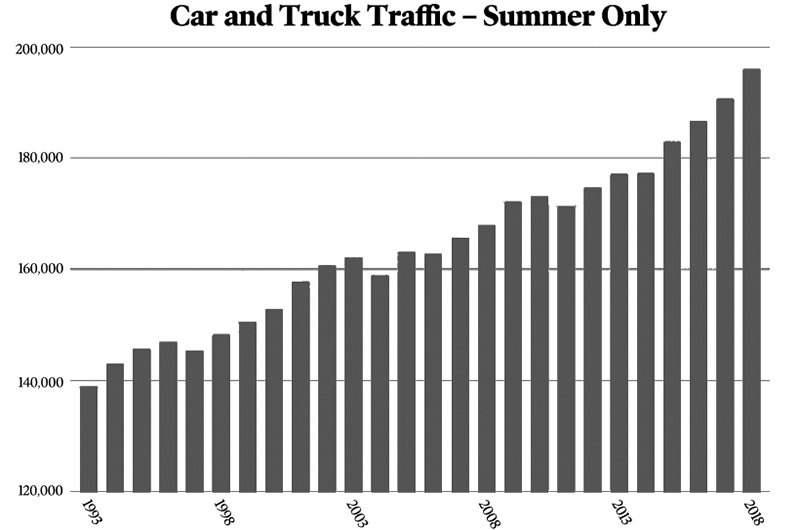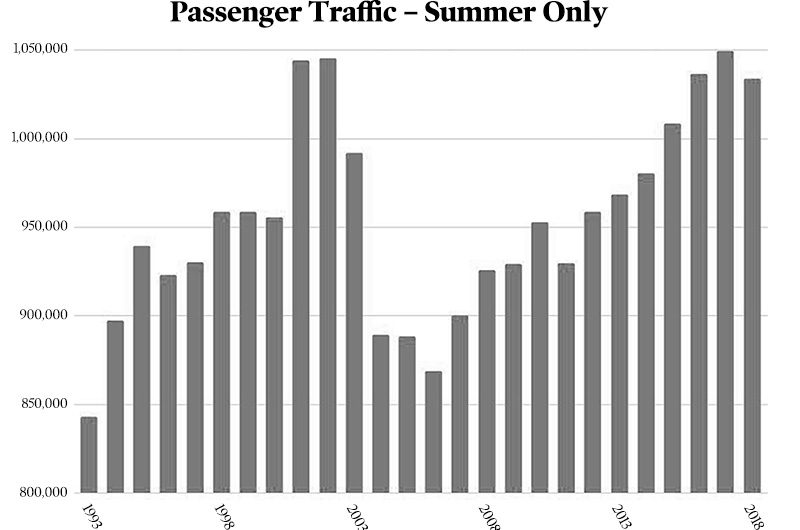For the third straight year the Steamship Authority carried a record number of cars and trucks on the Vineyard route this summer, part of an ongoing trend that shows more vehicles are traveling to the Island while foot traffic remains relatively flat.
The SSA provided traffic statistics this week for cars, trucks and passengers carried on the Vineyard route since 1993.
With some blips along the way, the numbers show a general upward trend in all types of traffic on the Vineyard route.
From June 1 through August 31 this year, a total of 157,114 cars were carried on the Vineyard route, up from 152,825 for the same period the previous year, and 150,595 the year before that. Both 2016 and 2017 were record-breaking years for cars carried on the Vineyard route.
In August alone this year the SSA carried 57,518 cars, an increase of more than 3,000 cars from August 2017. June and July also saw more automobiles carried, although the increases were somewhat smaller.
Last year the SSA carried a total 415,753 cars on the Vineyard route, which operates between Woods Hole and Vineyard Haven year-round, and between Woods Hole and Oak Bluffs from spring through fall.
Truck traffic is also on an upward trend, with 38,792 trucks carried in June, July and August, compared with 37,910 trucks carried in the same period in 2017.
Last year a total of 136,706 trucks were carried on the Vineyard route.
Car and truck traffic combined reflect similar upward trends. In 2010, 490,129 cars and trucks were carried on the Vineyard route. Seven years later in 2017, the boat line carried 552,459 cars and trucks.
Longer-term trends for truck traffic are harder to evaluate since in 2009 the SSA ended its previous practice of counting trucks of less than 20 feet in length as automobiles.
Traffic statistics show that passenger traffic has seen up-and-down trends through the years but stayed mostly flat in the past two years.
In June, July and August of this year the boat line carried 1,034,008 passengers on the Vineyard route, a small dip from the previous year when ferries carried 1,049,493 people.
Despite the slight decrease, this summer was the third highest for passenger traffic in SSA history. (Passenger traffic peaked in 2001 and 2002, then fell sharply before climbing again in roughly 2008.)
In 2017 2,466,548 passengers were carried on the Vineyard route.
Year to date the boat line has carried 167,139 automobiles, 66,202 trucks and 926,000 passengers.
SSA general manager Robert Davis said the increase in vehicle traffic can be tracked directly to added capacity on the Vineyard route. He said the freight ferry Sankaty, which previously served as a backup vessel, was put on the regular schedule this summer, allowing for an additional 15 trips per week.
“We’ve been responding to demand,” Mr. Davis told the Gazette.
He said he does not anticipate adding more trips in the future. “At this point we’re at capacity. We don’t have any other places to berth a vessel,” Mr. Davis said.
Historically, growth in ferry traffic and capacity on ferries has been a sticking point for Islanders. In 1997, voters in every Island town passed a nonbinding referendum to restrict cars carried on SSA ferries to 1995 levels. Numbers released this week show that 368,539 cars were carried that year.
In 2003 the topic surfaced again when the boat line began planning for the replacement of the ferry Islander with the Island Home, a vessel with more carrying capacity (76 cars compared to 50 on the Islander). At the time, former general manager Wayne Lamson assured residents that the authority would remove other vessels from the route to keep carrying capacity the same.
What eventually happened was different. Communications director Sean Driscoll said this week that every year from 2010 to 2017 the SSA added more trips on the Vineyard route to accommodate demand. He said that meant 1,200 additional trips.
Mr. Davis said senior managers come up with next year’s schedule based on demand, and at this point he said he does not plan to increase the number of trips.
“Our proposed summer schedules for next year are the same as this year,” he said. “We aren’t talking about adding trips at this point.”








Comments (17)
Comments
Comment policy »